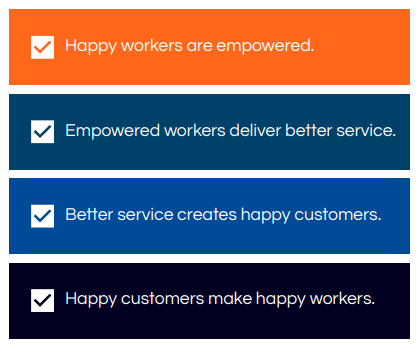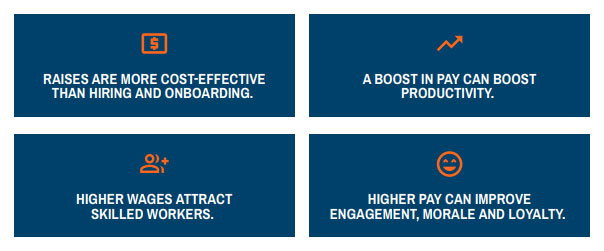The Ultimate Guide for Building Better Workplaces for Modern Frontline Workers
This guide provides practical tips, techniques, and best practices for building a better workplace for your frontline workers, ensuring they feel valued, connected, and engaged.
Download your own copy here, or scroll down to read the online version.
What You’ll Learn
- Perspectives from workers on the unique challenges they face
- The impact of company culture on business performance
- How employee feedback shapes company culture
- Engagement strategies for building better workplaces
As the needs of the modern worker evolve, it’s more important than ever for employers to create a company culture that inherently creates a positive and supportive workplace. This guide provides practical tips, techniques, and best practices for building a better workplace for your frontline workers.
The Challenges of the Frontline Workforce
From healthcare to retail to logistics and manufacturing, frontline workers stand at the forefront of company operations and customer service. These hardworking employees are the lifeblood of numerous industries, ensuring the smooth functioning of the world’s essential services. The roles that truck drivers, production line workers, warehouse employees, grocery staff and other frontline workers fill are crucial to modern society — a lesson we learned quickly in real life at the onset of the COVID-19 pandemic. And while most businesses have emerged from the wake of the crisis brought on by the virus, challenges in the workplace persist.
Despite their obvious importance — some might say a weighted one — frontline workers are the very ones who also often feel overlooked, disconnected from company culture, and that their growth opportunities are limited.
Demanding Schedules
The individual experiences of frontline workers vary widely depending on their roles, but most frontline jobs feature high-pressure environments with demanding schedules. These workers face daily stressors, including meeting performance targets, dealing with demanding customers, and adhering to strict safety protocols. Such factors can affect mental health, leading to burnout, disengagement, and a weakened sense of organizational loyalty.
Volatile External Pressures
Frontline workers often complete their jobs from the field — not at a computer. They’re driving trucks, working on the production line, engaging with consumers, and shuffling between patients.
Every day, while the work remains the same at its core, these experiences will change, depending on where the delivery is going, the price of fuel, which products are ordered, or who the customers are. These external factors act as changing pressures on the worker, leaving them in a near-constant state of flux. On the one hand, this keeps work exciting and fluid and is often a reason many frontline workers choose the line of work in the first place. But, employers need to understand that, on the other hand, this means that most of the workday is beyond the control of the average frontline worker. And that’s stressful.
“When considering workers’ actual needs, most employers have an ‘incomplete picture’, especially regarding the career advancement of the deskless worker.”
No Corporate Desk, No Corporate Ladder
Worse still, frontline workers often lack the same career advancement opportunities and upward mobility as their corporate-based counterparts. Recent research from McKinsey suggests it is because there is a stark difference in what employers think frontline workers want and what they do want.
When considering workers’ actual needs, most employers have an “incomplete picture,” especially regarding the career advancement of the deskless worker. For example, McKinsey found that while employers tend to think more highly of job titles, vacation time, and sick time, workers place a higher value on job growth, learning, and pay.
With dynamics like these at play, it’s easy to see how frontline workers may justly feel the weight of these factors and how they may contribute to dissatisfaction and disconnection.
The Effects of Pressure: How Culture Impacts Business
Happy Workers, Happy Customers
Up to 80% of customers say their experience with a company is as important as its products or services. In this way, the worker experience and customer experience are inextricably linked in the cycle of experience.

It’s also important to understand the repercussions of ignoring the employee experience. When left unchecked, the pressures of frontline work mount, leading to a dysfunctional workplace, dissatisfied workers and a disengaged workforce.
“Information breeds confidence. Silence breeds fear.”
Workers become dissatisfied, workforce morale drops, production suffers, and so does the customer experience.
And it typically starts with fear. When company culture becomes steeped in fear — of layoffs, of change, of other things left to gossip and imagination — workers become less satisfied with their jobs and more focused on their well-being. Fear convinces workers that they are expendable, and, in an act of professional survival, they reciprocate the feelings, placing less and less value on their work and the organization. Unfortunately, these issues are contagious, spreading like a toxic disease.
Using Feedback to Shape Company Culture
Frequent, ongoing communication gives leaders a chance to avoid gossip and fear, ensuring that worker concerns are heard, myths are dispelled, and accurate information is shared. This is especially important in times of change, like ownership changes or mergers and acquisitions.
When leaders engage regularly and commit to listening to the workforce, they open a two-way dialogue that shapes company culture by ensuring everyone has a chance to speak into it. This democratic approach keeps everyone involved, driving a sense of purpose and community within the organization — in turn, building a better customer experience shaped by a better worker experience.

Engagement Strategies for Building Better Workplaces
Practical Strategies for Supporting Frontline Workers
Frontline workers deal with outside influences, daily stressors, and other highly demanding work factors every time they return to their jobs. It’s imperative to recognize their hard work — with more than pizza parties and company swag.
Here are some practical ways companies can foster better company culture for their frontline workers and start building better workplaces.
Improve Onboarding and Hiring
Design an efficient hiring process. Get workers quickly acquainted with their jobs and the tools they need to perform and grow with the organization. And remember to recognize the dynamics of working from the field — frontline employees typically don’t have a desk and computer where they can fire off an email or walk over to another co-worker to ask a question. Make a concerted effort to acknowledge this, and arm your workers with the tools to do their work well and get help when needed. Onboarding and worker orientation should be a thoughtful process that considers not just the needs of the job but the needs of the worker.
Even more than this, ensure new staff know their value. Help them find pride in their contributions to the company. These early first impressions will shape their time with the company, and it’s one of the best opportunities to make a positive impact.
Establish and Maintain Competitive Wages
Research shows a positive correlation between wages and company earnings. Multiple studies have shown that higher wages can boost productivity, attract highly skilled talent — especially in tough labor markets — and even improve company engagement and morale.
With competitive pay rates, employers ensure they’re attracting the best possible talent who can thrive within their organization and help the company grow.

Create Clear Career Development Opportunities
Employees want more than just a paycheck. A recent APA study revealed that 77% of respondents ranked career development opportunities as crucial for employee retention. While career advancement and job promotions are definitely on the scale, there are many other opportunities to support workers through professional growth. These can include training programs, mentorship, tuition reimbursement, and other educational benefits.
By investing in personal growth, companies inherently cultivate skilled, confident workers who take pride in their contributions and feel valued by management and leadership teams. This positive work culture empowers employees to unleash their full potential, fostering loyalty and engagement throughout the entire workforce.
Using Real-Time Feedback for Operational Intelligence
To engage with frontline workers, it’s important to understand their lived experiences and perspectives — and not just theoretically. Impactful communication is a two-way operation that requires active listening. Because without listening, communication is just broadcasting.
Listening by Looking Within
When it comes to improving workplace dynamics, there is no better place to start than with the workforce itself. One effective method for listening is with a concept called “stay studies.” These retrospective initiatives have the same objectives as exit interviews, but instead of trying to understand why people leave the company, leadership teams survey current workers to understand their sentiments while they’re still employed.
This can take the form of periodic emails, company- or department-wide surveys, and anonymous questionnaires. Armed with these perspectives, leaders make key company decisions for retention based on a better understanding of workplace dynamics.
Listening in Real Time
While surveys and questionnaires do a good job of capturing information, the production effort can be extensive, requiring time-consuming question drafting, emailing workers, analyzing data, and more. These retrospective initiatives are also not particularly useful for direct problem-solving, which requires real-time intervention. For these reasons, stay studies and surveys are best reserved as annual or quarterly initiatives.
For more immediate and meaningful engagement, organizations should be reaching for real-time solutions. With real-time anonymous feedback directly from the workforce, leaders can spot trends across the organization, uncover dips in morale, and even identify sources of it. Organizations can correct misconceptions and make strategic decisions based on hard data and actual circumstances.

Building Better Workplaces with WorkHound
WorkHound allows employees to provide real-time anonymous feedback about their workplace experiences on a regular basis. This not only creates a sense of connection between workers and employers but also equips management with valuable insights to address pressing concerns and improve overall workplace dynamics.
How WorkHound Works
- Weekly Prompts: WorkHound regularly prompts workers to share honest, anonymous feedback about their work experience. This captures key data directly from the workforce.
- Real-Time Key Insights: Leadership teams can review and respond to feedback as it is shared, leveraging data-driven insights to best support your frontline workers.
- Impactful Communication: Keep workers informed and engaged by sharing plans to resolve raised issues. Let them know how their feedback supports the company.
- 2-Way Anonymous Chat: Managers can chat with workers to get more information about a raised issue with the convenience of an anonymous text message, chatting via text until the problem is resolved.
By addressing the challenges faced by frontline workers and harnessing the power of technology, organizations can create more supportive and connected workplaces. In turn, this helps build a positive workplace culture that drives employee satisfaction, retention, and overall business success.
The Power of Anonymity
Anonymous feedback fosters trust and honesty. Knowing they can preserve their anonymity, workers are happy to engage with managers and other company stakeholders through WorkHound. Anonymity also captures diverse feedback, giving everyone a voice by encouraging sharing for all personality types and eliminating the fear of reprisal or embarrassment.

Improved Company Communications

Boosted
Engagement

Operational Intelligence

Real-time Anonymous Feedback

Real-time Response Capabilities

Recruit and
Retain
Happy WorkHound Customers
With WorkHound, organizations around North America are leaning into engagement and building fundamentally healthier workplaces.

WorkHound is a game changer for a company that wants to reduce turnover!

It's actionable data in real-time. Data is coming in every day. We’re able to look at trends and things that are happening right away.

We joke internally that we just wish we had done it sooner.
WorkHound for Better Business Outcomes
A well-designed workplace promotes collaboration, creativity, and productivity, ultimately leading to improved business outcomes. By investing in employee well-being, providing opportunities for growth and development, and cultivating an inclusive and supportive culture, organizations can create better workplaces that empower employees — and companies — to reach their full potential.
Schedule your free demo to see what WorkHound can do for your workforce.
Let's Build Better Workplaces Together
Revolutionize your company culture and your worker retention rates by improving communication and engagement.
Book a Demo